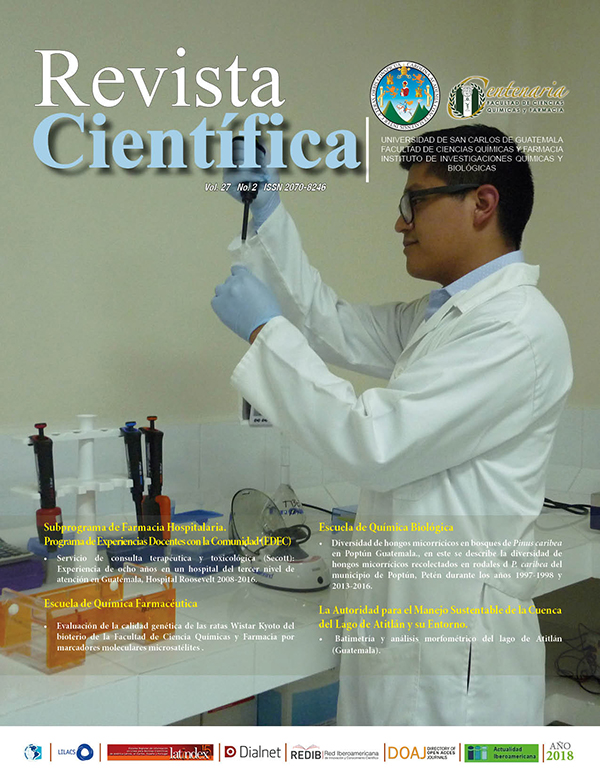Batimetría y análisis morfométrico del lago de Atitlán (Guatemala)
DOI:
https://doi.org/10.54495/Rev.Cientifica.v27i2.70Keywords:
morphometry, bathymetric map, hypsographic curve, effective fetch, deep tropical systemAbstract
The lake Atitlan basin is endorheic and is the deepest body of water in Central America. Information regarding its bathymetry and morphometry has not been updated since 1975.The objective of a bathymetric study in Lake Atitlán was to determine its morphometry and in the future, understand some physical, chemical and biological processes. For the bathymetric survey of Lake Atitlán, during 2014, depth data were taken along the lake with a multi-frecuency echo sounder. Later, the information was processed and 16 morphometric parameters were obtained, such as volume, area, perimeter, maximum depth, effective fetch, length and maximum width, among others. The surface area of the lake obtained was 125.77 km2, perimeter of 101.67 km and a volume of 25.46 km3. Lake Atitlan is a deep tropical system with a maximum depth of 327.56 m, an average depth of 203.21 m and concave; according to the hypsographic curve. The bathymetric map of the year 2014, presents few morphometric and morphological differences compare with the one that was realized in 1975.
Downloads
References
Alcocer, J., Oseguera, L., Sánchez, G., González, G., Martínez, J., & González, R. (2016). Bathymetric urveys of the Montebello Lakes, Chiapas. Journal of limnology, 75(1), 56-65. https://doi.org/10.4081/jlimnol.2016.1343
Anzidei, M., Carapezza, M., Esposito, A., Giordano, G., Lelli, M., & Tarchini, L. (2008). The albano maar lake high resolution bathymetry and disolved CO2 budget (Colli Albani volcano, Italy): Constrains to hazard evaluation. Journal of volcanology and geothermal research, 171(3-4), 258-268. https://doi.org/10.1016/j.jvolgeores.2007.11.024
Benjumea, C., Wills, A. & Aguirre, N. (2007). Principales aspectos morfométricos de la ciénaga de Cachimbero, Santander, Colombia. Gestión y ambiente, 11(2), 1-8.
Byrne, J. V., (1962). Bathymetry of crater lake, Oregon. The ore bin, 24(10), 161-164.
Cole, G. A. 1979. Textbook of Limnology. St. Louis,Toronto, London: The C. V. Mosby Company.
Fornerón, C., Piccolo, M. & Carbone, M.(2010). Análisis morfométrico de la laguna Sauce Grande (Argentina). Huellas, 14, 11-30.
Håkanson, L. (1981). A manual of lakemorphometry. Berlin: Springer Verlag. https://doi.org/10.1007/978-3-642-81563-8
Hernani, T. A. & Ramírez, J. J. 2002. Aspectosmorfométricos y teóricos de un embalse tropical de alta montaña: Represa La Fé, El Retiro Colombia. Caldasia, 101, 511-518. https://doi.org/10.18257/raccefyn.26(101).2002.2695
Hutchinson, G. E. (1957). A treatise on limnology. Vol I. Geography, physics and chemistry. New York, Chapman & Hall.
Kalff, J. (2002). Limnology. Inland Water Ecosystems. New Jersey: Prentice Hall.
Lewis, W. (1996). Tropical lakes: how latitude makes a difference. In: F. Schiemer & K.T. Boland (Eds.) Perspective in tropical limnology. (pp. 43-64). Amsterdam: SPB Academic Publishing.
Malhotra, A. & Fonseca, M. S. (2007). WEMo (Wave Exposure Model): Formulation, procedures and validation. (NOAA Technical memorandum NOS NCCOS #65). North Carolina: NOAA.
Margalef, R. (1983). Limnología. Barcelona, España: Omega.
Montoya - Moreno, Y. (2005). Caracterización morfométrica básica de tres lagos someros en el municipio de El Carmen de Viboral (Antioquia), Colombia. Actualidades biológicas, 27, 79-86. https://doi.org/10.17533/udea.acbi.329431
Murray, J. (1988). On the effects of winds on the distribution of temperatures in the sea and freshwater lochs of the west of Scotland. Scottish geographical magazine, 4(7), 345 - 357. https://doi.org/10.1080/14702548808554534
Reyes, F., Barreno, F., Arriola, I., Martínez, M., Martínez, C., Xamínez, N, & Ujpan, D. (2016). Informe monitoreo limnológico 2016. Departamento de investigación y calidad ambiental de la autoridad para
el manejo sustentable de la cuenca del lago de Atitlán y su entorno. Sololá, Guatemala.
Rico, E., Chicote, A., González, M.E.& Montes, C.(1995). Batimetría y análisis morfométrico del lago de Arreo (N. España). Limnética, 11(1), 55-58. https://doi.org/10.23818/limn.11.07
Roldán, G. & Ramírez, J. (2008). Fundamentos de limnología neotropical. Antioquia, Colombia: Editorial Universidad de Antioquía.
Santizo, A. & Secaira, E. (Eds.) (2007). Plan maestro de la reserva de uso múltiple cuenca del Lago de Atitlán. Consejo Nacional de Áreas Protegidas (CONAP). Guatemala. Guatemala: Serviprensa.
Takano, B., Suzuki, K., Sugimori, K., Ohba, T., Fazlullin, S., Bernard, A. Hirabayashi, M. (2004) Bathymetric and geochemical investigation of Kawak Ijen Crater Lake, East Java, Indonesia. Journal of volcanology and geothermal research, 135(4), 299-329. https://doi.org/10.1016/j.jvolgeores.2004.03.008
Wetzel, R.G. (1983). Limnology. Philadelphia: Saunders College Publishing.
Wetzel, R. (2001). Limnology: Lake and river ecosistems. San Diego: Academic Press.
Wirrmann, D. (1991). Morfología y batimetría. In: C. Dejouxy A. Iltis (Eds.) El Lago Titicaca, síntesis del conocimiento limnológico actual. (pp. 31-37). La Paz: Hisbol - ORSTOM.
Xaminez, N. & Reyes, R. (2016). Informe anual. Monitoreo del nivel del lago, 2016. Departamento de investigación y calidad ambiental de la autoridad para el manejo sustentable de la cuenca del lago de Atitlán y su entorno. Sololá, Guatemala.
Yesuf, H., Alamirew, T., Melesse, A. & Assen, M. (2013). Bathymetric study of Lake Hayq, Ethiopia. Lakes and reservoirs: research and management. 18, 55-165. https://doi.org/10.1111/lre.12024
Downloads
Published
How to Cite
Issue
Section
License
Copyright (c) 2018 Fátima Reyes Morales, Domingo Ujpan, Samuel Valiente

This work is licensed under a Creative Commons Attribution 4.0 International License.
Authors who publish with this journal agree to the following terms:
- Authors retain copyright and grant the journal right of first publication with the work simultaneously licensed under a Creative Commons Attribution License 4.0 that allows others to share the work with an acknowledgement of the work's authorship and initial publication in this journal.
- Authors are able to enter into separate, additional contractual arrangements for the non-exclusive distribution of the journal's published version of the work (e.g., post it to an institutional repository or publish it in a book), with an acknowledgement of its initial publication in this journal.
- Authors are permitted and encouraged to post their work online (e.g., in institutional repositories or on their website) prior to and during the submission process, as it can lead to productive exchanges, as well as earlier and greater citation of published work.









